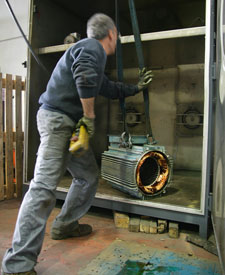Protection against dust
Protection against dust explosive
You can use various types of protection to meet the ATEX Directive EHSR depending on the area where the equipment is installed .
The purpose of protection is to prevent the engine from becoming a possible explosive source .
The technical solution depends EHSR of ATEX Directive according to the category of the equipment.
 |
Protection type ” D “, ” dip ” or ” Ex td ” prevent : |
| Type of protection | Protection based Protection Type |
| Dust ignition proof / td Ex – IP 55 |
|
| Resistant to dust ignition / td Ex – IP 65 |
|
temperature class
The brand temperature corresponds to the temperature of the engine class . In the case of engine ignition protected against dust , this temperature corresponds to the maximum temperature of the outer surface of the product.
Users must follow different rules depending on the gaseous environment to install a motor in an explosive atmosphere .
The limits described in the following table should be followed in all cases in accordance with the ATEX Directive and IEC standards :
| Brand engine temperature | Temperature Environment dust ignition | Minimum ignition temperature of potentially explosive atmosphere | |
| T °C (125°C) | Cloud | T°cloud | T°cloud > 3/2 x T°C (190°C) |
| Layer up to 5 mm (gruix del motor) | T°5mm | T°5mm > T°C + 75 K (200°C) | |
Protection against dust explosive
You can use various types of protection to meet the ATEX Directive EHSR depending on the area where the equipment is installed .
The purpose of protection is to prevent the engine from becoming a possible explosive source .
The technical solution depends EHSR of ATEX Directive according to the category of the equipment.
Protection type ” D “, ” dip ” or ” Ex td ” prevent :
presence of explosive dust atmosphere
Protection based Protection Type
Dust ignition proof / td Ex – IP 55
Explosive dust can not penetrate in sufficient quantity as to interfere with the active part of the motor inside the engine protected ..
Absence of high temperature surfaces and dangerous sparks on the outside of the casing in nominal operating conditions .
Resistant to dust ignition / td Ex –
IP 65
IP 65 explosive dust can not penetrate inside the motor impervious to dust.
Absence of dangerous surfaces at high temperatures and sparks on the outside of the casing at nominal operating conditions and under certain conditions of failure.
temperature class
The brand temperature corresponds to the temperature of the engine class . In the case of engine ignition protected against dust , this temperature corresponds to the maximum temperature of the outer surface of the product.
Users must follow different rules depending on the gaseous environment to install a motor in an explosive atmosphere .
The limits described in the following table should be followed in all cases in accordance with the ATEX Directive and IEC standards :
Brand engine temperature Temperature Environment dust ignition Minimum ignition temperature of potentially explosive atmosphere
T ° C ( 125 ° C ) Cloud Cloud T ° T ° Cloud > 3/2 x T ° C ( 190 ° C )
Layer up to 5 mm (thickness engine ) T ° ° 5mm 5mm T > T C + 75 ° K (200 ° C )
With a higher layer of 5 mm, special requirements are needed . Please check with the manufacturer .
| Standards affected by protection ” DIP / Ex td ” : | |
| EN 61241-1 : 2004-06 Electrical apparatus for use in presence of combustible dust . Part 1 : Protection by enclosure ” td ” according to IEC 61261-1
EN 50281-1-1:1998 Electrical equipment for use in presence of combustible dust . Part 1-1 : Electrical equipment protected by shells – Construction and testing . EN 50281-1-2:1998 Electrical equipment for use in presence of combustible dust . Part 1-2 : Electrical apparatus protected by shells – Selection , installation and maintenance IEC 61241-0 : 2004-07 Electrical apparatus for use in presence of combustible dust . Part 0 : General requirements . IEC 61241-14 : 2004-07 Electrical apparatus for use in presence of combustible dust . Part 14 : Selection and installation General characteristics for the design of ABB motors type of protection against ignition of dust. |
|
- Minimum distance values and vanishing open spaces in accordance with the latest edition of the standards
- Insulating material with the highest class of mechanical strength
IP 54 or IP 55 protection for Zone 22 areas with non-conductive dust )
IP 65 protection for Zone 21 or Zone 22 areas with conductive dust - The space between the fan and the cover should be at least 1% of the maximum diameter of the fan with a minimum value of 1 mm and a maximum of 5 mm.
- The insulation resistance of fans, fan cover and ventilation screen should not exceed 1 Gohm whatever peripheral speed fan for dusty environment
- The fan , its cover and ventilation screen should not contain mass composed of more than 7.5% magnesium .
- All surfaces that are electrically charged , they should be connected to ground or connected
- Determining the temperature of a surface to set the relevant temperature class ( external and internal ) is performed by measuring the increase in maximum temperature peak reached in the most unfavorable conditions including food tolerances required by the standard :
+ / – 5% of the nominal voltage if the motor patella according to IEC 60034-1
+ / – 10% of the nominal voltage if the motor patella according to IEC 60038 (or IEC 60079-0 ) -
In both cases , an additional margin of 5 K
Prevention of risks from static electricity by using material with insulation resistance less than 1 Gohm













